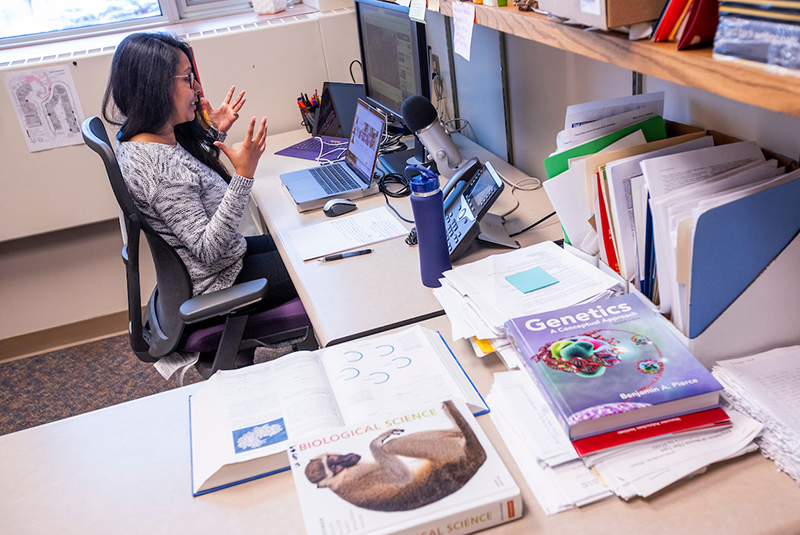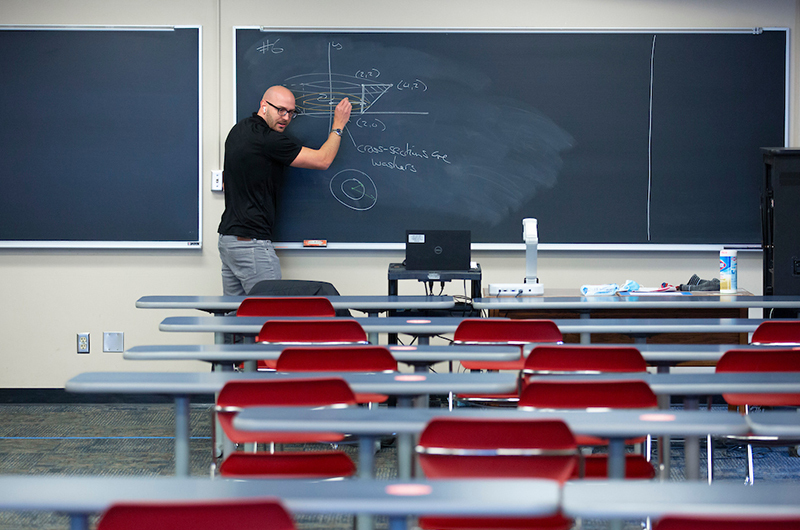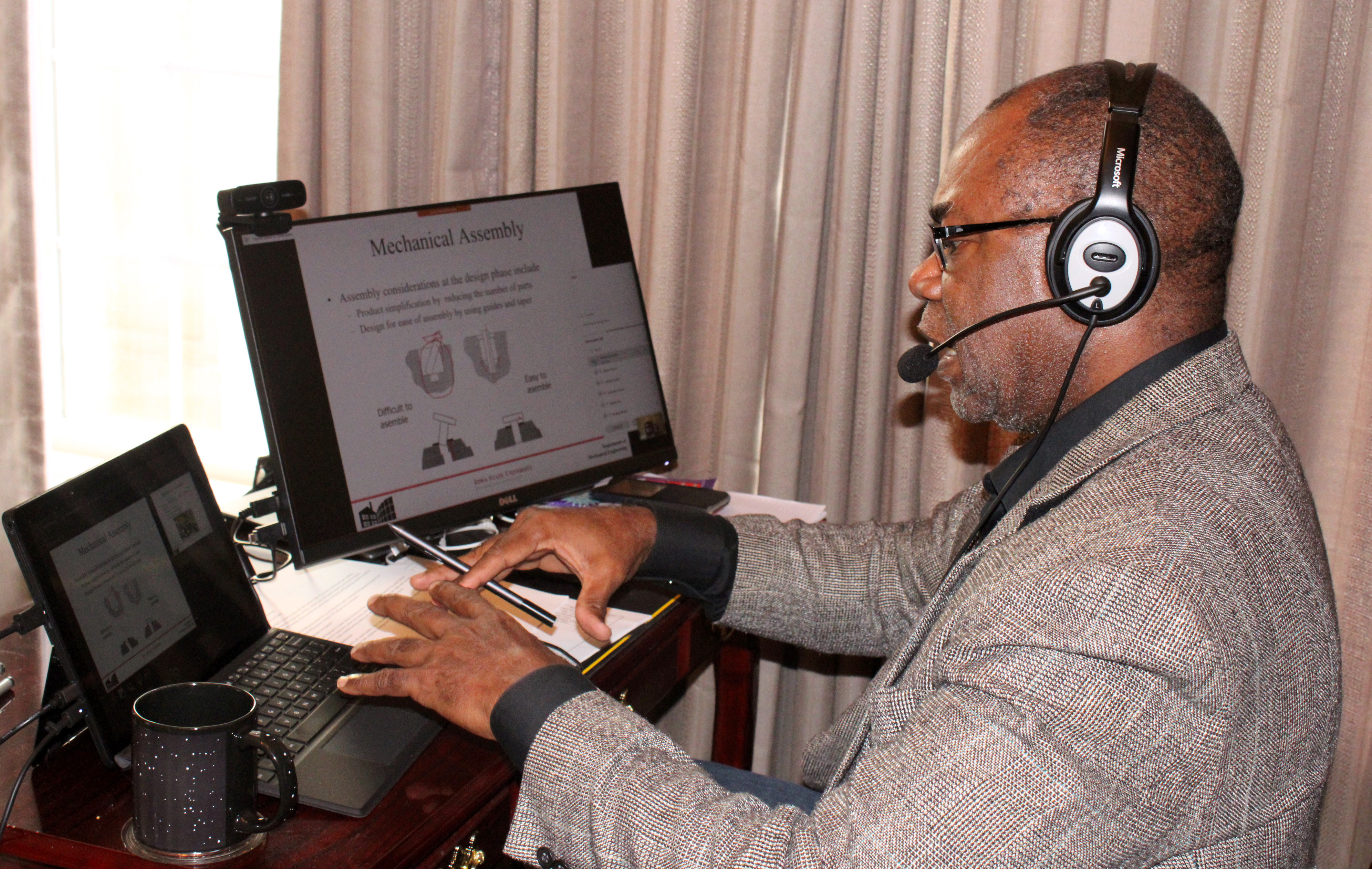Nearly 2,300 students enroll in winter session

Associate teaching professor Sayali Kukday, genetics, development and cell biology, leads a daily help session from her office in the Molecular Biology Building. Photo by Christopher Gannon.
Iowa State seniors are taking advantage of the university's first-ever winter session. The senior class, which made up 34% of ISU undergraduates this fall, represents 43% of the 2,297 students enrolled as of Dec. 16. Classes began Monday in a compressed 25-day term that concludes Jan. 21 with final exams. Classes won't meet on the four university holidays between now and then.
Five of the 52 courses offered for winter session filled, and another 19 reached 90% -- or higher -- of their enrollment capacity. Just one course was dropped due to low enrollment.
"Our students' interest exceeded all expectations," said Beate Schmittmann, dean of the College of Liberal Arts and Sciences and co-chair of the winter session planning committee. "This is an experiment. We really didn't know what to expect, but I'm not sure we thought we'd get to 2,000. It's a very good response from our students."
Schmittmann said for several courses the LAS college actually added resources to assist the instructor -- for example, a graduate assistant or grader -- and raised the enrollment cap in response to student demand. About one-fourth of all courses offered this session are in the LAS college.
Enrollment by level
|
Students |
Number enrolled |
% of total |
|
Seniors |
989 |
43 |
|
Juniors |
605 |
26 |
|
Sophomores |
425 |
18 |
|
Freshmen |
271 |
12 |
|
Not seeking degrees |
7 |
<1 |
|
Total |
2,297 |
100 |
15 into five
Emmanuel Agba, teaching professor of mechanical engineering and a former Ford Motor Co. engineer, has taught the 400-level computer-aided design for five consecutive semesters, with the class typically filling the first day of registration. The waiting list for spring semester contains more than a dozen names. So, the demand is there and he has a library of digital resources, but he hadn't offered the course on a compressed schedule. He praises the computer savviness of ISU students, so much so that when his department chair inquired about winter session, he responded "let's try it" and carved his project-based content into five weeks.
The goal, he said, is that his 27 students spend no more than six hours a day on ME 419. Four mornings a week, he will spend 80 synchronous minutes with them, delivering a live lecture he records and posts in Canvas and leading them into that day's project. He follows with "office hours" from 11 a.m. to noon -- an opportunity for one-on-one discussions about their projects -- and responds to many emails. Studying and completing the project and weekly exams round out the student's day.
Agba said the most difficult part for students about the five-week term may be deciding if they're on board with the volume of work. Once they commit to that, "now they don't have to worry about it, they just have to do a lot of work."
He observed this week that students who retained skills they learned in prerequisite courses -- or perhaps are using them in an internship -- will be successful in the five-week term. There may not be time in a compressed schedule to relearn or research previous material, he said. That's why the class's synchronous session includes project work time, "so we can move quickly and get some of the work done in class every day."
All six undergraduate colleges are offering courses that likely hit one or more of these targets:
- Meets a university requirement (for example, general education, diversity)
- Useful to students in a variety of majors (popular electives)
- Offered previously in an accelerated summer format
- Enrolls large numbers, particularly in the spring semester (offering it now could alleviate some of the pressure on spring sections)
Full-time effort

Math assistant teaching professor Dane Mayhook leads an online study session in an empty Carver Hall classroom Monday afternoon. Photo by Christopher Gannon.
Math assistant teaching professor Dane Mayhook is leading one of the few four-credit courses offered winter session, Calculus II. His students consume at least two lectures a day (recorded by department veterans Steve Butler and Paul Barloon and archived on the department's YouTube channel). Mayhook leads daily synchronous help sessions, reviews daily homework and administers an end-of-week exam to keep his 70 students moving forward.
The course marks the first time Iowa State is offering calculus in a session that's shorter than eight weeks.
"I'm optimistic about the outcome," he said, "but I advised them to treat this class like a full-time job. It's a lot of work."
An experiment
Associate teaching professor Sayali Kukday, genetics, development and cell biology department, previously taught the 200-level Principles of Biology for a 15-week semester and eight-week summer term. She said she's approaching the five-week term "as a scientist approaches an experiment."
"I recognize this will be a huge challenge, but I'm excited about it," she said. "When the instructor and the students work together, I know I can help them get to the finish line."
In addition to organizing her winter course content into four modules -- when a student completes one the next one unlocks -- she said she's putting extra effort into communicating expectations and supporting students' needs. In fact, she made "develop a sense of community" one of her course goals. Teaching asynchronously online has taught her that students who feel like they are part of a community are more likely to ask questions and collaborate with classmates.
Kukday leads three of the daily synchronous help sessions each week, and her undergraduate assistants lead the other two. Each day's session, at least for now, has a focus such as vocabulary building, study skills or content/concepts.
Hindsight
Schmittmann said key considerations for the planning committee in measuring the success of winter session after it concludes are:
- Students' ability to complete the coursework
- Student and faculty interest in doing it again

From his home, mechanical engineering teaching professor Emmanuel Agba leads one of four weekly live lectures with his winter session students. Photo courtesy of Amara Agba.
Facilities, services are open for students during partial shutdown
Campus operations will be limited between Christmas and New Year's this year, as they are every winter. During the 11-day optional and partial shutdown Dec. 24-Jan. 3, units can choose to reduce services or close to save on energy costs and allow faculty and staff to take time off to recharge during the holiday season.
But this year, for the first time, some faculty will be teaching during the partial closure. Iowa State is offering undergraduates the opportunity to take one of 51 online courses during a 25-day winter session Dec. 14-Jan. 21. Class is in session every weekday during that period, other than on university holidays (Dec. 24-25, Jan. 1 and Jan. 18).
In planning for the partial shutdown period, department and unit leaders need to ensure adequate staffing to support the nearly 2,300 students taking an online course during that time, senior vice president for operations and finance Pam Cain and vice president for university human resources Kristi Darr said in an Oct. 16 memo to university administrative officers.
Many campuswide student-focused services and facilities, both in-person and online, also will be available for some portion of the partial shutdown period. Here are some examples:
- Parks Library will be open Dec. 28-31 (7:30 a.m.-5 p.m.) and Jan. 3 (12:30-5 p.m.).
- The Memorial Union will be open Dec. 28-31 (7 a.m.-7 p.m.), closing one hour earlier on Dec. 31.
- ISU Dining will offer limited food service. Clyde's will be open Dec. 28-30, Friley Windows on Dec. 24 and Dec. 27-31, and Union Drive Marketplace on Jan. 3.
- Though its physical office in the Hixson-Lied Student Success Center will be closed Dec. 28-31, some Academic Success Center staff will be working remotely. The center is open 7:30 a.m.-4 p.m. during winter break.
- Thielen Student Health Center and student counseling services will be open for usual winter break hours, closing at 4 p.m.
- Recreation services will open Beyer Hall and State Gym Dec. 28-31 (noon-7 p.m.).
- ISU Book Store will be open Dec. 28-31 (10 a.m.-5 p.m.).
How ISU child care centers are navigating COVID-19
When the COVID-19 pandemic struck in March, the three campus child care centers closed due to health and safety concerns. As the centers planned for their summer reopenings, Cris Broshar expected trying months ahead.
"I was preparing for many messages back and forth throughout the fall semester regarding closures or quarantines," said Broshar, worklife and family services program coordinator.
While child care is different and more difficult when mitigating COVID-19 risks, the deluge Broshar was bracing for hasn't emerged. Other than a handful of individual classroom closures, the centers stayed open throughout the fall.
"It's absolutely been a success," she said.
Procedures in place
The centers have followed the guidelines established by state regulators. Included in those measures: staff and children age 2 or older wear face coverings, everyone undergoes daily health screenings, parents aren't allowed inside facilities and mixing among student groups is restricted.
Physical-distancing protocols required a reduction in capacity. The combined pre-pandemic capacity of ISU centers is 232 children, based on the practices recommended by their national accrediting organization. That's down to about 150 during the pandemic, which carries a big budget impact.
"Even at full capacity, under normal operations, the profit margins for child care are very, very small," Broshar said. "They're maximizing every last penny so they can keep their doors open."
The centers are applying for some grants to help. They've also reduced staff as much as possible, which puts additional strain on those who remain.
"We have really prided ourselves in providing the highest quality of care," Broshar said. "A lot of times, that means having extra hands to help manage the groups."
New leadership
During the pandemic, Broshar transitioned into her coordinator position that leads child care and family services, an office within university human resources that manages the contracts for University Community Childcare (UCC) and ISU Child Care Center at Veterinary Medicine. (The other center, Child Development Laboratory School, is operated by the College of Human Sciences.)
Julie Graden, the program coordinator for 21 years, has been on phased retirement since September 2019 and retires Dec. 31. Broshar was hired as the office's program assistant in January 2019 and officially became the coordinator about three months ago.
"It's been nice having both of us with a lot of experience to find our way through this," said Graden, who counts COVID-19 as one of the biggest challenges of her tenure -- along with the 2010 flood at the Family Resource Center that displaced UCC for months.
In addition to overseeing the contracted centers, child care and family services staff administer the federal CCAMPIS grant that has provided nearly $3 million in child care subsidies for student parents, serve as a resource for students and employees seeking child care and lead the initiative to expand campus lactation spaces. Broshar also has organized virtual events during the pandemic, including a weekly Family Friday series of webinars and three Family Forum town hall sessions for parents to discuss child care challenges and solutions.
Renovation proceeding
One ISU child care program that closed for the pandemic won't be reopening. The Comfort Zone had provided care for mildly ill children in a space in the Family Resource Center since 1993 before closing in March. Under the recommendations of a child care task force approved by President Wendy Wintersteen earlier this fall, the little-used Comfort Zone program will stay closed and the physical space in the building will be converted into additional infant care space.
Broshar said renovation planning is underway, with hopes of beginning work this spring and possibly opening in the fall. The project will add eight slots for infants, which are in high demand at the campus centers.
Smile and Write provides structure in an abnormal time
Laura Brown was looking for a little structure during a time when so much about daily life feels anything but normal.
The assistant English professor found it through the Smile and Write program offered by the provost's office. It uses peer accountability to help faculty and staff keep their writing projects on track while connecting with others in the program.
"There is so little in my day that is structured right now, so it has been very helpful to have this structure around my writing and research," Brown said. "It is nice that it is not something I have to set up, and it is someone else bringing the group together and getting it going."
The provost's office previously offered writing accountability groups in which individuals were paired with a mentor, but this option focuses strictly on writing.
"Especially for our tenure-track faculty, they need something that gets them on this path of writing whether it be articles, books or whatever their discipline requires," said faculty success coordinator Katharine Hensley.
How it works
The program began this fall, meeting on Zoom Tuesdays from 11 a.m. to 1 p.m. Participation ranges from five to 15 people. Meeting virtually has proven beneficial for faculty and staff.
"It actually makes it easier than meeting in person because you don't have to leave your office to join the group and work for two hours," Hensley said. "It is really simple."
Each meeting begins with participants telling the group their goals for the session. Once work begins, microphones are muted but cameras stay on. As the session draws to a close, people again take turns talking about what they accomplished or what challenges still are present.
"It has been nice to have a space where you are writing with other people and hearing what they are working on," Brown said. "People are excited about their projects -- and that can be really motivating. Or, if there are moments when people are really frustrated with a project, that makes me feel better because that is often how I feel."
Registration is available through Learn@ISU. Six winter session dates were added at the request of participants, four of which remain: Dec. 29, Jan. 5, Jan. 12 and Jan. 19.
Multiple benefits
Brown has been working on an essay during the sessions and plans to devote upcoming time to developing her online spring courses in Canvas.
"I'm excited to have those concrete times on the calendar when I know I will have to sit down and chip away at it," she said. "The accountability and having something on the calendar that I can't move is important. I think that is true for a lot of faculty."
Philosophy and religious studies associate professor Travis Chilcott had been looking for a writing community when he came across Write and Smile.
"I have the need to get some writing done in the middle of the craziness of this pandemic, and the semester is so consumed by teaching," he said. "I was extremely happy when the provost's office did this."
Chilcott has attended every session as he works on his book manuscript.
"We are in isolation and writing can be a very lonely process, so this program has created a community and a sense of solidarity," he said.
"Overwhelmingly, I hear from faculty that it is an opportunity to work on things maybe they don't want to work on or get pushed to the back burner because they have other things to do," Hensley said.
Participants also meet faculty and staff they might not interact with otherwise.
"It is nice to meet people you may not normally cross paths with, and it might turn into someone you seek advice from or work with that you had not anticipated," Brown said.
Going forward
Smile and Write will expand in the spring semester with two sessions each week, one at a fixed time and another floating day to make it available to more faculty and staff who are interested.
"Just having that accountability is something I learned I really rely on and makes a difference in how much I'm able to get done," Brown said.
